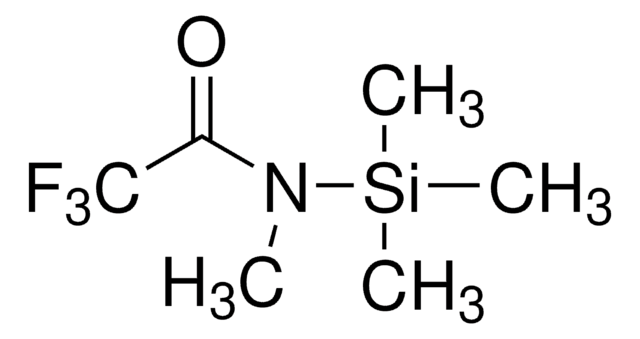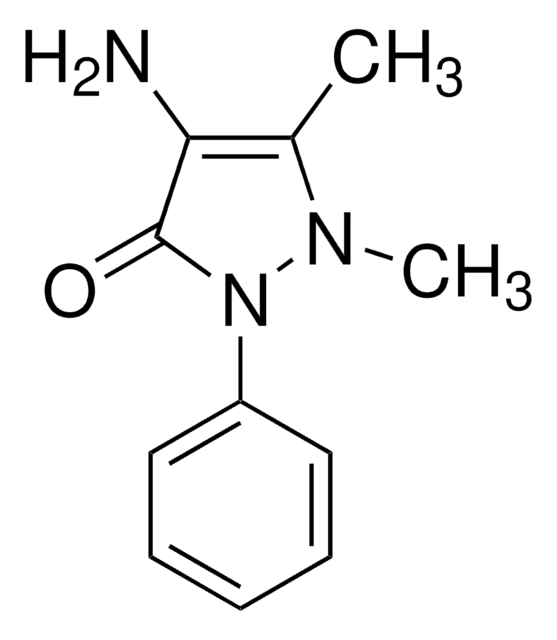Wichtige Dokumente
69484
N-Methyl-N-trimethylsilylheptafluorbuttersäureamid
for GC derivatization, LiChropur™, ≥90% (GC)
Synonym(e):
N-Trimethylsilyl-N-methylheptafluorbuttersäureamid, MSHFBA
About This Item
Empfohlene Produkte
Qualität
derivatization grade ((GC derivatization))
for GC derivatization
LiChropur™
Qualitätsniveau
Assay
≥90% (GC)
Form
liquid
Eignung der Reaktion
reagent type: derivatization reagent
reaction type: Silylations
Methode(n)
gas chromatography (GC): suitable
Brechungsindex
n20/D 1.353 (lit.)
n20/D 1.353
bp
148 °C (lit.)
Dichte
1.254 g/mL at 25 °C (lit.)
SMILES String
CN(C(=O)C(F)(F)C(F)(F)C(F)(F)F)[Si](C)(C)C
InChI
1S/C8H12F7NOSi/c1-16(18(2,3)4)5(17)6(9,10)7(11,12)8(13,14)15/h1-4H3
InChIKey
CMXKINNDZCNCEI-UHFFFAOYSA-N
Suchen Sie nach ähnlichen Produkten? Aufrufen Leitfaden zum Produktvergleich
Anwendung
- Simultaneous quantitation of cocaine, opiates, and their metabolites in human hair by positive ion chemical ionization gas chromatography-mass spectrometry: Diese Studie zeigt die Anwendung von N-Methyl-N-(trimethylsilyl)heptafluorobutyramid in der forensischen Toxikologie zur Analyse von Drogenrückständen im menschlichen Haar und bietet eine solide Methode zum Nachweis solcher Verbindungen im Spurenbereich (Höld KM, Wilkins DG, Rollins DE, Joseph RE Jr, Cone EJ, 1998).
- Detection of stanozolol in hair by negative ion chemical ionization mass spectrometry: Diese Forschungsarbeit verwendet N-Methyl-N-(trimethylsilyl)heptafluorobutyramid für den empfindlichen Nachweis von Stanozolol, einem leistungssteigernden Steroid, in Haarproben. Diese Methode ist besonders bei Dopinganalysen im Sport nützlich, um faire Spiele zu gewährleisten (Höld KM, Wilkins DG, Crouch DJ, Rollins DE, Maes RA, 1996).
Sonstige Hinweise
Rechtliche Hinweise
Ähnliches Produkt
Signalwort
Warning
H-Sätze
Gefahreneinstufungen
Eye Irrit. 2 - Flam. Liq. 3 - Skin Irrit. 2 - STOT SE 3
Zielorgane
Respiratory system
Lagerklassenschlüssel
3 - Flammable liquids
WGK
WGK 3
Flammpunkt (°F)
91.4 °F - closed cup
Flammpunkt (°C)
33 °C - closed cup
Persönliche Schutzausrüstung
Eyeshields, Faceshields, Gloves, type ABEK (EN14387) respirator filter
Hier finden Sie alle aktuellen Versionen:
Analysenzertifikate (COA)
Die passende Version wird nicht angezeigt?
Wenn Sie eine bestimmte Version benötigen, können Sie anhand der Lot- oder Chargennummer nach einem spezifischen Zertifikat suchen.
Besitzen Sie dieses Produkt bereits?
In der Dokumentenbibliothek finden Sie die Dokumentation zu den Produkten, die Sie kürzlich erworben haben.
Kunden haben sich ebenfalls angesehen
Artikel
Results of a study involving the ability few Fluka silylating reagents to form GC-MS-compatible trimethylsilylmethyl derivatives of NSAIDs
Unser Team von Wissenschaftlern verfügt über Erfahrung in allen Forschungsbereichen einschließlich Life Science, Materialwissenschaften, chemischer Synthese, Chromatographie, Analytik und vielen mehr..
Setzen Sie sich mit dem technischen Dienst in Verbindung.









